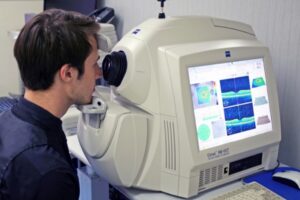Presbyopia is derived from the Greek word “presby” and “ops” meaning old-age sight.
Presbyopia is age related loss of ability to sustain accommodation necessary for clear near vision or presbyopia can be said to be the inability of the eye, to focus sharply on nearby objects, resulting from loss of elasticity of the crystalline lens with advancing age. Usually after 40 years, it is difficult to read and close work. Presbyopia is a normal and expected part of the aging process.
The ciliary muscle still contracts as it should. Presbyopia occurs because the crystalline lens becomes harder over the years. With age it cannot become steeper when the muscle contracts. Thus the power of the lens accommodate reduces.
Presbyopia Treatment: The goal of treatment is to focus on the objects around your eye disability. Options for treating presbyopia include wearing corrective glasses (contact lenses) or contact lenses, performing refractive surgery, or taking lens implants for presbyopia.
Prescription for reading glasses: If you do not have any other vision problems, you can use glasses with a prescription lens for reading. You will need to remove the glasses when you do not read.
Bifocals: These lenses have a visible separate line that separates your distance. Distance power is above the line and Near power is below the line.
Trifocal: This glass have correction for distance vision, middle distance vision and near vision. The trifocal lens has two visible horizontal lines.
Progressive multifocal: This type of lens has no visible horizontal lines. It has multiple powers for distance, middle distance and close-up corrections. There are different focusing strengths in different areas.
Progressives for office: This progressive lenses is used when using computer and while reading. And you have to remove it to see the distance.
If you don’t want to use glasses, you can use contact lenses.
Bifocal Contact lenses: using bifocal contact lenses you can easily see the distance and near.
Monovision contact lenses: To use this contact lens you have to wear a contact lens for distance vision (usually your dominant eye) a contact lens for close-up vision.
Refractive surgery: Refractive surgery changes the shape of the cornea of the eye. In this surgery near vision improves and patients can be seen easily without glass contact lens.
Refractive surgical procedures are –
Conductive keratoplasty.
Laser-assisted in situ keratomileusis (LASIK).
Laser-assisted subepithelial keratectomy (LASEK).
Photorefractive keratectomy (PRK).
Lens implants:
This is a procedure where the lens of your eye is removed and the synthetic lens is replaced. Many types of lens implants are used to correct presbyopia.
The natural crystal lens of the eye is replaced with an intra-ocular lens (IOL), which can effectively reduce or decrease the need to read glasses.
Coming soon: presbyopia-correcting eye drops
Presbyopia correcting eye drop is not available in the market now. This eye drop cannot fix permanent presbyopia. lt can be used for temporary purposes. There are two types of drops that can be used to treat presbyopia.
Miotic eye drops: Miotic eye drop reduces presbyopia by creating a pinhole effect. The depth of focus increases when the pupil is constricts, which improves the ability to focus closer to the eye without affecting the ability to see from a distance.
Lens softening eye drops: This solution softens the lenses of the eyes. So can focus on different objects at different distances. A research has shown that lens softening eye drops continue working for many years.
Lifestyle and home remedies: Presbyopia cannot be prevented but there are some tips to keep your eyes healthy.
You need to be aware of your health Condition. You do regular eye checkup. Chronic diseases like diabetes, high blood pressure need to be controlled because they affect the eyes. Use correct glasses or contact lenses after examining your eyes. Use sunglasses to block UV radiation for protect your eyes.
Eat fruits, vegetables and healthy foods everyday.
Presbyopia is a normal problem. Everyone should be aware and do regular eye checkup by your nearest optometrist or ophthalmologist.








